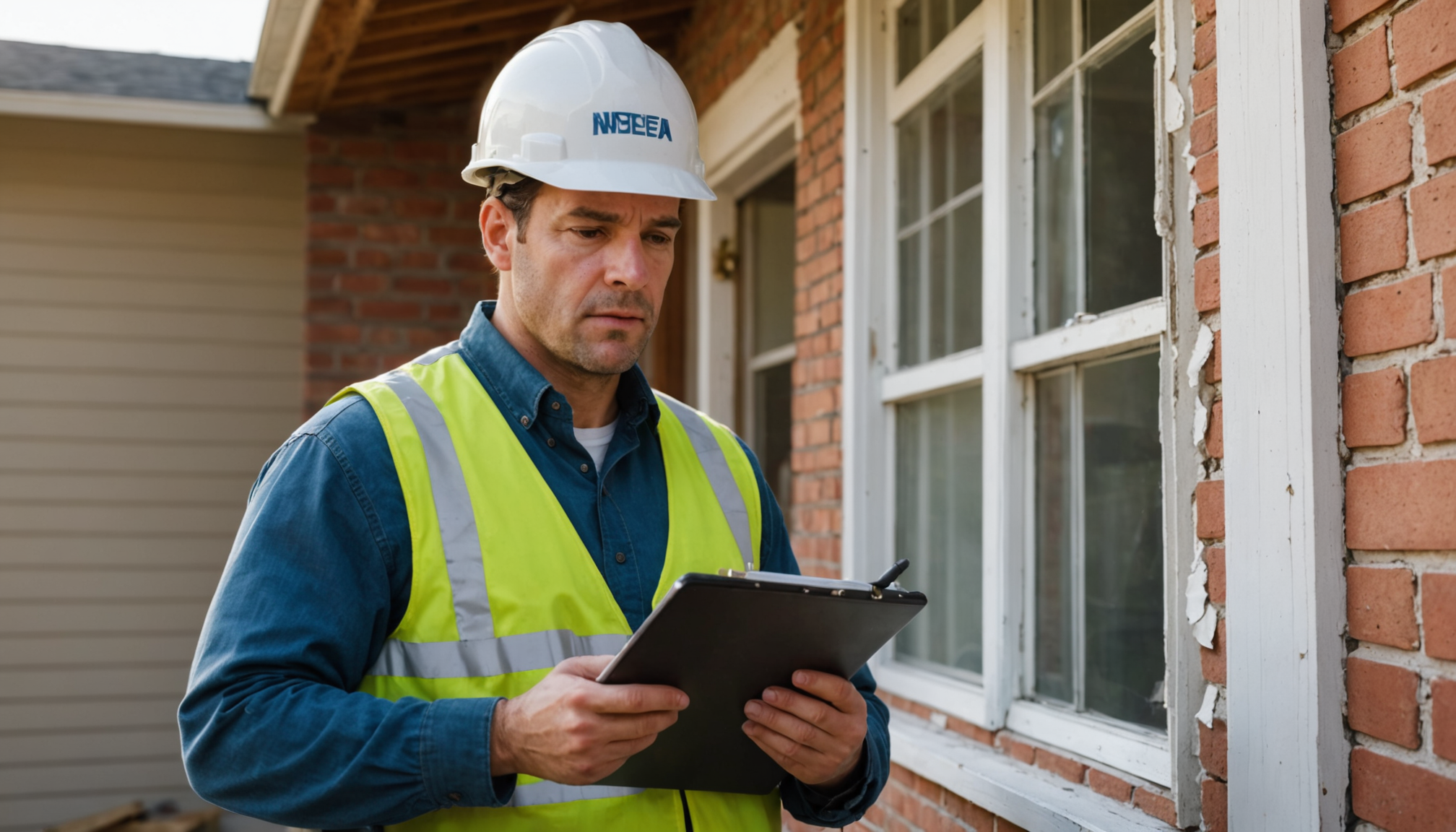When dealing with home damage, the first step you must undertake is to assess the situation comprehensively. This initial assessment is crucial as it will inform all subsequent actions and decisions. Begin by conducting a thorough examination of the affected area to understand the extent and nature of the damage. It is important to consider both visible and potential hidden damages, as some issues may not be immediately apparent.
Start by inspecting the exterior of the home, checking for structural issues such as cracks in walls, broken windows, or roof damage. These can often be indicative of more serious underlying problems that aren’t immediately visible. Next, move inside to evaluate internal damage. Look for signs of water leakage, mold, or compromised electrical systems. Water damage is particularly insidious as it can worsen over time if not addressed promptly.
During your assessment, safety should be your top priority. If any section of the home appears unstable or there is a risk of electrical hazards, it is wise to vacate that area immediately and consult with a professional. It’s also important to check for any gas leaks if the home has a gas supply. If you smell gas or suspect a leak, evacuate the premises at once and contact emergency services.
Creating a detailed list of damages is essential for keeping track of all issues. This documentation will be invaluable for your insurance claim and any repair work. A structured approach might include categorizing damages by rooms or areas affected:
- Exterior: Roof, walls, gutters, windows
- Interior: Walls, ceilings, flooring
- Utilities: Electrical, plumbing, heating
- Furnishings and Personal Belongings: Furniture, appliances, other personal items
Understanding the type of damage impacts how you will proceed with repairs and insurance claims. Here’s a basic comparison table to differentiate between major and minor damages usually encountered:
| Type of Damage | Characteristics |
| Major | Structural damage (e.g., foundation issues), extensive water damage, major fire damage |
| Minor | Cosmetic damage (e.g., paint, minor wall cracks), small leaks, broken windows |
A comprehensive assessment followed by meticulous documentation will ensure you have a solid foundation from which to address repairs and communicate effectively with your insurance provider. Remember that haste can lead to oversights, so take your time to assess every aspect thoroughly, ensuring nothing is overlooked that could complicate repair efforts or insurance claims later.
contact your insurance provider
Once you’ve completed a thorough evaluation of the damage, the next crucial step is to reach out to your insurance provider without delay. This early communication is key to initiating the claims process and understanding what coverage options are available to you. Here’s a step-by-step guide to effectively contacting your insurance provider:
- Locate Your Insurance Policy: Before making contact, have your insurance policy details at hand. This includes your policy number and any specific coverage details related to property damage. Understanding your policy will help facilitate a more informed discussion.
- Contact Information: Find the contact information for your insurance provider. This may include a dedicated claims line or an online portal for submitting claims. Many insurance companies have 24/7 hotlines for emergencies, so be sure to use these resources if applicable.
- Describe the Damage: When you speak with your representative, clearly articulate the extent and nature of the damage. Be prepared to answer questions such as when the damage occurred, what caused it, and which parts of your home are affected. Use the detailed list you created during your assessment for reference during this conversation.
- Follow Their Procedures: Your insurance provider will guide you through their specific procedures for filing a claim. This can include filling out specific forms, providing documentation of the damage, or meeting with an insurance adjuster. Adhere closely to these procedures to avoid delays in your claim process.
- Document Your Interaction: Keep a detailed record of all communications with your insurance company. Note the dates of conversations, names of representatives you speak with, and key points discussed. This documentation will be invaluable in case of any disputes or discrepancies later on.
- Ask Questions: Don’t hesitate to ask questions if any part of the claims process is unclear. Understanding your rights and the steps involved will empower you to navigate the process effectively. Ask about timelines, what’s covered, any costs you might incur, and how claims are typically processed.
Maintaining open communication with your insurance provider and closely following the outlined steps will facilitate a smoother claims process, allowing you to focus more on recovery and less on administrative hurdles. Remember, a prompt and detailed approach can significantly impact the efficiency and success of your claim.
document everything
In the aftermath of home damage, one of the most vital actions you can take is to meticulously record every detail concerning the damage and any related interactions. This thorough documentation process encompasses several dimensions and serves multiple purposes, making it an indispensable step in both immediate and long-term recovery efforts.
First and foremost, you’ll want to capture comprehensive photographic and video evidence of all damage, both external and internal. Use your smartphone or a camera to take high-resolution photos from multiple angles, ensuring you cover all affected areas. Photographic evidence is compelling and helps provide a clear, objective view of the damage, both for your records and in supporting any claims with your insurer or contractors. When capturing images, ensure that they are time-stamped or included in an organized manner to reference later.
In addition to visual documentation, it’s equally important to create a written record of events and observations. Start with a detailed narrative of how and when the damage event occurred, providing context that can be invaluable if details are needed for an insurance claim or repairs. This narrative should detail the sequence of events leading up to the damage, the immediate aftermath, and first steps taken in response.
Your journal or digital note should also track all interactions related to resolving the damage. This includes noting phone calls, emails, or meetings with your insurance company, contractors, or any other professionals involved. Keep a chronological log of these interactions to maintain clarity on who said what and when. This time-stamped log can protect you if discrepancies or misunderstandings arise during the claims process.
It’s crucial to keep receipts and records of all expenses you incur as a direct result of the damage. This may include costs for temporary housing, emergency repairs, or any other sudden costs necessary to maintain safety or comfort. Collecting and organizing these receipts systematically ensures you’re prepared to provide proof of expenses to your insurance company or for tax purposes.
Lastly, consider using a digital tool or app to consolidate all this information in one easily accessible location. Many apps are specifically designed to help homeowners manage damage documentation and track claims efficiently. Such tools can streamline the data collection process and ensure that nothing falls through the cracks, providing an audit trail that is both robust and user-friendly.
Overall, documenting everything thoroughly not only helps guarantee that all damage is accounted for, but it also empowers you to manage the recovery process with confidence. It’s a proactive measure that supports you in reclaiming control over a challenging situation by clarifying circumstances and prerequisites for effective communication and negotiation with all parties involved.
make necessary repairs
After addressing the initial assessment and contacting your insurance provider, the next priority is to take action on making necessary repairs. This step focuses on securing your home and preventing further damage while ensuring that any repair work complies with safety standards and insurance requirements.
Start with temporary fixes that mitigate further damage. These can include covering broken windows with plastic sheeting, sealing roof leaks with tarps, or shutting off water valves to stop leaking pipes. These initial actions are crucial, as insurance policies often necessitate that homeowners demonstrate they have taken steps to prevent additional damage. Document each temporary repair with photographs and receipts, as this evidence can support your insurance claim.
Once you have stopped further damage, it’s time to engage with professional contractors for estimates and repairs. Gather multiple quotes to compare costs and check for any local regulations that might apply to repairs post-damage. Ensure the contractors are licensed, insured, and familiar with your type of damage. This diligence not only helps avoid overpayment but also secures quality work that complies with both legal standards and insurance requirements.
You might find some repairs fall within your skillset for DIY solutions, especially if they are minor, such as repainting, fixing a loose door handle, or patching up small drywall holes. It’s important to assess your comfort level and expertise with such tasks to ensure they are completed safely and correctly. However, for major structural work, always defer to professionals.
Consider the timing and sequence of repairs carefully. Some fixes might need to happen before others, such as ensuring electrical systems are inspected and safe before addressing cosmetic issues in the same area. Collaborate with contractors to develop a timeline that maximizes efficiency and minimizes disruptions to your home life.
Maintain communication with your insurance provider throughout the repair process. Keep them informed of all progress with detailed records, ensuring the work corresponds with your policy’s coverage stipulations. Transparency here aids in claim settlements and prevents future disputes should additional coverage be warranted.
Finally, remember that patience is key. Repair and recovery can be a lengthy process, especially if catastrophic weather events are causing delays due to high demand for contractors and supplies. Stay organized, proactive, and maintain open lines of communication with all parties involved to smooth the way forward.
This step not only restores the function and safety of your home but also fortifies it against future incidents. Embracing a structured approach to repairs lays a solid foundation for long-term peace of mind.
plan for prevention
Planning for future prevention is essential for minimizing the risk of recurring damage to your home. Begin by thoroughly reviewing what led to the initial damage and identifying areas of vulnerability. Whether the harm was caused by natural disasters, accidents, or wear and tear, understanding the root causes can help you devise effective prevention strategies.
First, enhance your home’s resilience against specific threats. For example, if your area is prone to floods, consider installing flood barriers, elevating electrical outlets, and using water-resistant building materials. If wind damage is a concern, reinforce structures with storm shutters and secure roofing materials. Addressing potential risk factors specific to your locality can greatly reduce the likelihood of damage.
Regular maintenance plays a critical role in prevention. Schedule routine inspections of your home’s key systems – roof, plumbing, electrical, and HVAC. Timely identification and repair of wear and tear can prevent minor issues from escalating into major problems. Keep gutters clean, trim nearby trees, and inspect and maintain the siding and foundation of your home.
It’s also beneficial to review and update your home insurance coverage to align with identified risks. Consult with your insurance agent to ensure your policy covers all potential threats relevant to your area. Consider endorsements or additional coverage options for hazards not included in your standard policy. This proactive approach to insurance helps mitigate financial loss in the event of future incidents.
Incorporating technological solutions can further safeguard your home. Invest in smart home devices like moisture sensors or security cameras that alert you to immediate risks, providing peace of mind and prompt response capabilities. Enhanced home surveillance and monitoring ensure that potential issues are addressed before they develop into significant damage.
Finally, develop and rehearse an emergency action plan for your household. This plan should detail evacuation procedures, emergency contacts, and necessary supplies. Regular drills ensure that everyone in the household knows how to respond effectively during crises, significantly enhancing personal safety and reducing panic.
By implementing these precautionary measures, you can effectively safeguard your home against future damage, ensuring a more secure and stress-free living environment.
In conclusion, dealing with home damage involves a systematic approach that begins with assessing the damage, contacting your insurance provider, and documenting everything. Making necessary repairs and planning for future prevention are equally pivotal. Each step plays an integral role in not only restoring your home but also strengthening its defenses against future damages. Being proactive and organized not only eases the burden of recovery but also provides peace of mind, knowing you’re better prepared to protect your cherished space.


